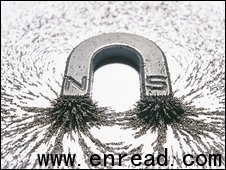Wireless power system shown off 无线供电系统亮相
(单词翻译:单击)
A system that can deliver power to devices without the need for wires has been shown off at a hi-tech conference.
一个高科技展会上,一套无线供电系统亮相。

Magnetic fields interact with everyday objects less than electric fields
The technique exploits simple physics and can be used to charge a range of electronic devices.
Eric Giler, chief executive of US firm Witricity, showed mobile phones and televisions charging wirelessly1 at the TED2 Global conference in Oxford3.
He said the system could replace the miles of expensive power cables and billions of disposable batteries.
"There is something like 40 billion disposable batteries built every year for power that, generally speaking, is used within a few inches or feet of where there is very inexpensive power," he said.
Trillions of dollars, he said, had also been invested building an infrastructure4 of wires "to get power from where it is created to where it is used."
"We love this stuff [electricity] so much," he said.
Mr Giler showed off a Google G1 phone and an Apple iPhone that could be charged using the system.
Witricity, he said, had managed to pack all the necessary components5 into the body of the G1 phone, but Apple had made that process slightly harder.
"They don't make it easy at Apple to get inside their phones so we put a little sleeve on the back," he said.
He also showed off a commercially available television using the system.
"Imagine you get one of these things and you want to hang it on the wall," he said. "Think about it, you don't want those ugly cords hanging down."
Good vibrations6
The system is based on work by physicist7 Marin Soljacic at the Massachusetts Institute of Technology (MIT).
It exploits "resonance8(共鸣,共振)", whereby energy transfer is markedly more efficient when a certain frequency is applied9.
When two objects have the same resonant10 frequency, they exchange energy strongly without having an effect on other, surrounding objects.
For example, it is resonance that can cause a wine glass to explode when a singer hits exactly the right tone.
But instead of using acoustic11(声,声响) resonance, Witricity's approach exploits the resonance of low frequency electromagnetic waves.
The system uses two coils(镀锡卷板,卷带马口铁) - one plugged into the mains and the other embedded12 or attached to the gadget13.
Each coil is carefully engineered with the same resonant frequency. When the main coil is connected to an electricity supply, the magnetic field(磁场) it produces is resonant with that of with the second coil, allowing "tails" of energy to flow between them.
As each "cycle" of energy arrives at the second coil, a voltage begins to build up that can be used to charge the gadget.
Mr Giler said the main coil could be embedded in the "ceiling, in the floor, or underneath14 your desktop15".
Devices using the system would automatically begin to charge as soon as they were within range, he said.
"You'd never have to worry about plugging these things in again."
 收听单词发音
收听单词发音
1
wirelessly

|
|
| 不用电线的,用无线电波传送的 | |
参考例句: |
|
|
|
2
ted

|
|
| vt.翻晒,撒,撒开 | |
参考例句: |
|
|
|
3
Oxford

|
|
| n.牛津(英国城市) | |
参考例句: |
|
|
|
4
infrastructure

|
|
| n.下部构造,下部组织,基础结构,基础设施 | |
参考例句: |
|
|
|
5
components

|
|
| (机器、设备等的)构成要素,零件,成分; 成分( component的名词复数 ); [物理化学]组分; [数学]分量; (混合物的)组成部分 | |
参考例句: |
|
|
|
6
vibrations

|
|
| n.摆动( vibration的名词复数 );震动;感受;(偏离平衡位置的)一次性往复振动 | |
参考例句: |
|
|
|
7
physicist

|
|
| n.物理学家,研究物理学的人 | |
参考例句: |
|
|
|
8
resonance

|
|
| n.洪亮;共鸣;共振 | |
参考例句: |
|
|
|
9
applied

|
|
| adj.应用的;v.应用,适用 | |
参考例句: |
|
|
|
10
resonant

|
|
| adj.(声音)洪亮的,共鸣的 | |
参考例句: |
|
|
|
11
acoustic

|
|
| adj.听觉的,声音的;(乐器)原声的 | |
参考例句: |
|
|
|
12
embedded

|
|
| a.扎牢的 | |
参考例句: |
|
|
|
13
gadget

|
|
| n.小巧的机械,精巧的装置,小玩意儿 | |
参考例句: |
|
|
|
14
underneath

|
|
| adj.在...下面,在...底下;adv.在下面 | |
参考例句: |
|
|
|
15
desktop

|
|
| n.桌面管理系统程序;台式 | |
参考例句: |
|
|
|




